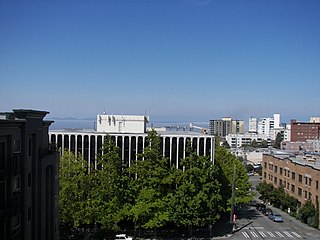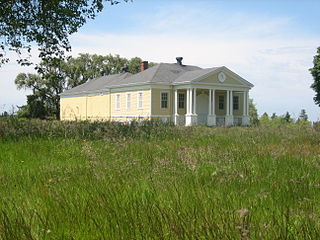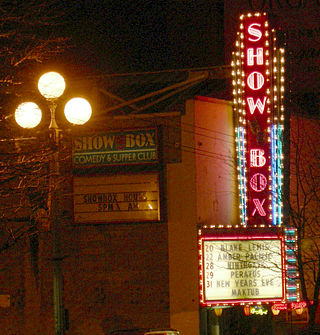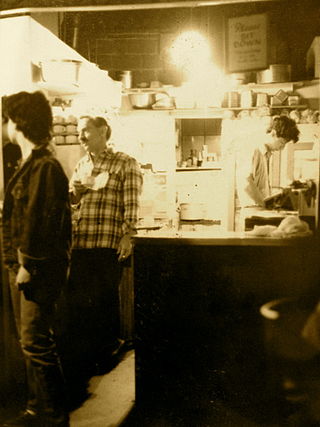
The Century 21 Exposition was a world's fair held April 21, 1962, to October 21, 1962, in Seattle, Washington, United States. Nearly 10 million people attended the fair during its six-month run.

Quetzaltenango is both the seat of the namesake Department and municipality, in Guatemala. The city is located in a mountain valley at an elevation of 2,330 meters above sea level at its lowest part. It may reach above 2,400 m (7,900 ft) within the city.

Seattle Center is an entertainment, education, tourism and performing arts center located in the Lower Queen Anne neighborhood of Seattle, Washington, United States. Constructed for the 1962 World's Fair, Seattle Center's landmark feature is the 605 ft (184 m) Space Needle, an official city landmark and globally recognized symbol of Seattle's skyline. Other notable attractions include the Pacific Science Center, Climate Pledge Arena, and Museum of Pop Culture (MoPOP), as well as McCaw Hall, which hosts both the Seattle Opera and Pacific Northwest Ballet. The Seattle Center Monorail provides regular public transit service between Seattle Center and Westlake Center in Downtown Seattle, and is itself considered a tourist attraction.

Capitol Hill is a densely populated residential district in Seattle, Washington, United States. One of the city's most popular nightlife and entertainment districts, it is home to a historic gay village and vibrant counterculture community.

Volunteer Park is a 48.3-acre (19.5 ha) park in the Capitol Hill neighborhood of Seattle, Washington, United States.

Consolidated Works was a "multi-disciplinary contemporary arts center" located successively in two former warehouses in the South Lake Union neighborhood of Seattle, Washington, USA, just west of what would be considered the Cascade neighborhood within South Lake Union. It incorporated an art gallery, theater, cinema, and music/dance/lecture hall, as well as studio spaces for artists and a bar and lounge.

Lower Queen Anne is a neighborhood in Seattle, Washington, at the base of Queen Anne Hill. While its boundaries are not precise, the toponym usually refers to the shopping, office, and residential districts to the north and west of Seattle Center. The neighborhood is connected to Upper Queen Anne—the shopping district at the top of the hill—by an extremely steep section of Queen Anne Avenue N. known as the Counterbalance, in memory of the cable cars that once ran up and down it.
Landmark Theatres is a movie theatre chain founded in 1974 in the United States. It was formerly dedicated to exhibiting and marketing independent and foreign films. Landmark consists of 34 theatres with 176 screens in 24 markets. It is known for both its historic and newer, more modern theatres. Helmed by its President Kevin Holloway, Landmark Theatres is part of Cohen Media Group.

Fort Lawton was a United States Army post located in the Magnolia neighborhood of Seattle, Washington overlooking Puget Sound. In 1973 a large majority of the property, 534 acres of Fort Lawton, was given to the city of Seattle and dedicated as Discovery Park. Both the fort and the nearby residential neighborhood of Lawton Wood are named after Major General Henry Ware Lawton.

The Grand Illusion Cinema is the longest running independent cinema in the city of Seattle, Washington, and has become a landmark of the film community. Opened as The Movie House in 1970, the cinema became the city's first intimate arthouse and showcased foreign and revival films. The Grand Illusion is located in Seattle's University District.

The Embassy of Mexico in Washington, D.C., houses the diplomatic mission from Mexico to the United States.

ACT Contemporary Theatre is a regional, non-profit theatre organization in Seattle, in the US state of Washington. Gregory A. Falls (1922–1997) founded ACT in 1965 and served as its first Artistic director; at the time ACT was founded he was also head of the Drama Department at the University of Washington. Falls was identified with the theatrical avant garde of the time, and founded ACT because he saw the Seattle Repertory Theatre as too specifically devoted to classics.

The Showbox is a music venue in Seattle, Washington, United States. It has been owned by AEG Live since 2007.

Colonia San Rafael is a colonia of the Cuauhtémoc borough of Mexico City, just west of the historic city center. It was established in the late 19th century as one of the first formal neighborhoods outside of the city center and initially catered to the wealthy of the Porfirio Díaz era. These early residents built large mansions, many with French influence, and many still remain. Middle class residents moved in soon afterwards, and building and rebuilding over the 20th century has introduced a number of architectural styles. These buildings include some of the first works by Luis Barragán and today 383 are classified as having historic value.

The Last Exit on Brooklyn was a Seattle University District coffeehouse established in 1967 by Irv Cisski. It is known for its part in the history of Seattle's counterculture, for its pioneering role in establishing Seattle's coffee culture, and as a former chess venue frequented by several master players.

Village East by Angelika is a movie theater at 189 Second Avenue, on the corner with 12th Street, in the East Village of Manhattan in New York City. Part of the former Yiddish Theatre District, the theater was designed in the Moorish Revival style by Harrison Wiseman and built from 1925 to 1926 by Louis Jaffe. In addition to Yiddish theatre, the theater has hosted off-Broadway shows, burlesque, and movies. Since 1991, it has been operated by Angelika Film Center as a seven-screen multiplex. Both the exterior and interior of the theater are New York City designated landmarks, and the theater is on the National Register of Historic Places.

The Neptune Theatre, formerly known as U-Neptune Theatre, is a performing arts venue in the University District neighborhood of Seattle, Washington, United States. Opened in 1921, the 1,000 capacity venue hosts a variety of events, including dance and music performances, film screenings, and arts education. It was primarily used for screening classic films prior to a 2011 renovation. In 2014, the theater and building were designated a Seattle landmark.

At the advent of the 20th century, the city of Portland, Oregon, was among the first on the United States West Coast to embrace the advent of the silent and feature film. The city's first movie palace, the Majestic Theatre, opened in 1911. By 1916, Portland had "the finest array" of movie houses on the West Coast relative to its population, pioneering venues dedicated exclusively to screening films. The popularization of the sound film in the early 1920s resulted in another boom of new cinemas being constructed, including the Laurelhurst, the Hollywood Theatre, and the Bagdad Theatre, the latter of which was financed by Universal Pictures in 1926.

















